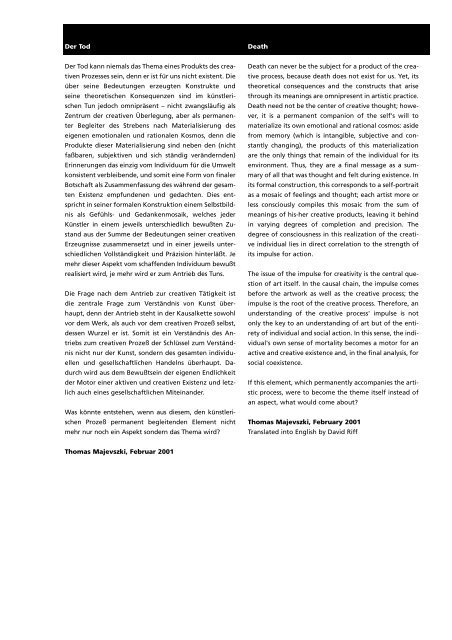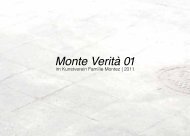Berlin Ausstellung: Der Tod 21. April – 19. Mai 2001
Berlin Ausstellung: Der Tod 21. April – 19. Mai 2001
Berlin Ausstellung: Der Tod 21. April – 19. Mai 2001
Sie wollen auch ein ePaper? Erhöhen Sie die Reichweite Ihrer Titel.
YUMPU macht aus Druck-PDFs automatisch weboptimierte ePaper, die Google liebt.
<strong>Der</strong> <strong>Tod</strong><br />
<strong>Der</strong> <strong>Tod</strong> kann niemals das Thema eines Produkts des creativen<br />
Prozesses sein, denn er ist für uns nicht existent. Die<br />
über seine Bedeutungen erzeugten Konstrukte und<br />
seine theoretischen Konsequenzen sind im künstlerischen<br />
Tun jedoch omnipräsent – nicht zwangsläufig als<br />
Zentrum der creativen Überlegung, aber als permanenter<br />
Begleiter des Strebens nach Materialisierung des<br />
eigenen emotionalen und rationalen Kosmos, denn die<br />
Produkte dieser Materialisierung sind neben den (nicht<br />
faßbaren, subjektiven und sich ständig verändernden)<br />
Erinnerungen das einzig vom Individuum für die Umwelt<br />
konsistent verbleibende, und somit eine Form von finaler<br />
Botschaft als Zusammenfassung des während der gesamten<br />
Existenz empfundenen und gedachten. Dies entspricht<br />
in seiner formalen Konstruktion einem Selbstbildnis<br />
als Gefühls- und Gedankenmosaik, welches jeder<br />
Künstler in einem jeweils unterschiedlich bewußten Zustand<br />
aus der Summe der Bedeutungen seiner creativen<br />
Erzeugnisse zusammensetzt und in einer jeweils unterschiedlichen<br />
Vollständigkeit und Präzision hinterläßt. Je<br />
mehr dieser Aspekt vom schaffenden Individuum bewußt<br />
realisiert wird, je mehr wird er zum Antrieb des Tuns.<br />
Die Frage nach dem Antrieb zur creativen Tätigkeit ist<br />
die zentrale Frage zum Verständnis von Kunst überhaupt,<br />
denn der Antrieb steht in der Kausalkette sowohl<br />
vor dem Werk, als auch vor dem creativen Prozeß selbst,<br />
dessen Wurzel er ist. Somit ist ein Verständnis des Antriebs<br />
zum creativen Prozeß der Schlüssel zum Verständnis<br />
nicht nur der Kunst, sondern des gesamten individuellen<br />
und gesellschaftlichen Handelns überhaupt. Dadurch<br />
wird aus dem Bewußtsein der eigenen Endlichkeit<br />
der Motor einer aktiven und creativen Existenz und letzlich<br />
auch eines gesellschaftlichen Miteinander.<br />
Was könnte entstehen, wenn aus diesem, den künstlerischen<br />
Prozeß permanent begleitenden Element nicht<br />
mehr nur noch ein Aspekt sondern das Thema wird?<br />
Thomas Majevszki, Februar <strong>2001</strong><br />
Death<br />
Death can never be the subject for a product of the creative<br />
process, because death does not exist for us. Yet, its<br />
theoretical consequences and the constructs that arise<br />
through its meanings are omnipresent in artistic practice.<br />
Death need not be the center of creative thought; however,<br />
it is a permanent companion of the self's will to<br />
materialize its own emotional and rational cosmos: aside<br />
from memory (which is intangible, subjective and constantly<br />
changing), the products of this materialization<br />
are the only things that remain of the individual for its<br />
environment. Thus, they are a final message as a summary<br />
of all that was thought and felt during existence. In<br />
its formal construction, this corresponds to a self-portrait<br />
as a mosaic of feelings and thought; each artist more or<br />
less consciously compiles this mosaic from the sum of<br />
meanings of his-her creative products, leaving it behind<br />
in varying degrees of completion and precision. The<br />
degree of consciousness in this realization of the creative<br />
individual lies in direct correlation to the strength of<br />
its impulse for action.<br />
The issue of the impulse for creativity is the central question<br />
of art itself. In the causal chain, the impulse comes<br />
before the artwork as well as the creative process; the<br />
impulse is the root of the creative process. Therefore, an<br />
understanding of the creative process' impulse is not<br />
only the key to an understanding of art but of the entirety<br />
of individual and social action. In this sense, the individual's<br />
own sense of mortality becomes a motor for an<br />
active and creative existence and, in the final analysis, for<br />
social coexistence.<br />
If this element, which permanently accompanies the artistic<br />
process, were to become the theme itself instead of<br />
an aspect, what would come about?<br />
Thomas Majevszki, February <strong>2001</strong><br />
Translated into English by David Riff



